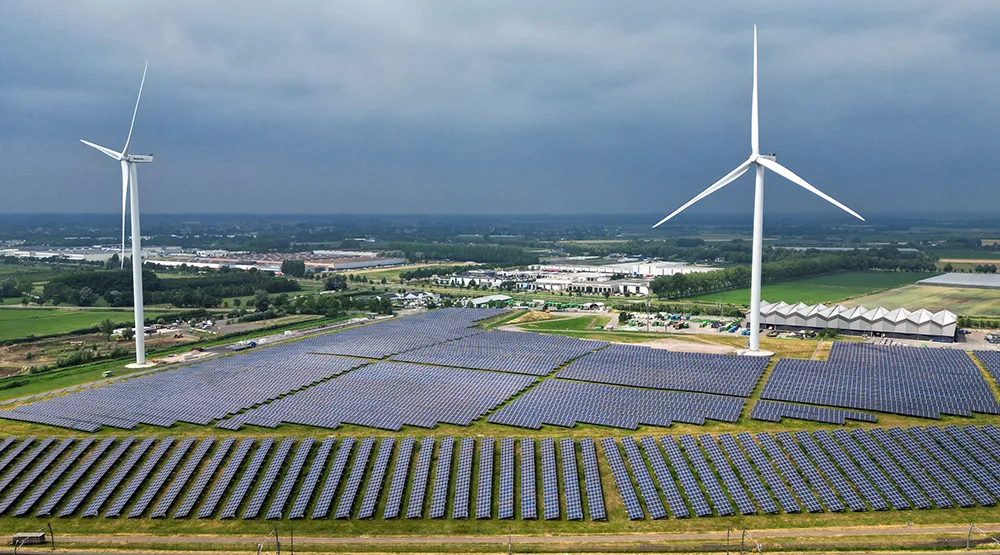
Learn how turning toward cleaner energy sources means factoring in economic and energy needs alongside environmental ones.
Last Updated July 25, 2023
A solar panel park and wind turbines are seen along the highway in Geldermalsen, Netherlands on June 28, 2023.
Source: Piroschka van de Wouw / Reuters
If you want to be eco-friendly, you should be driving an electric car. Right?
Unfortunately, it is not as simple as that. While electric cars do not pollute the air around them like a combustion engine does, they do need to be charged, leading to questions such as what energy source the electricity is coming from and whether that energy source is clean.
The overall evaluation of an energy source is based not only on how clean it is; it also has to be reliable, accessible, and affordable. Not all of these factors can be categorized neatly. For example, petroleum tends to be relatively affordable in the United States, but that is in part because the government subsidizes fossil fuel industries. Similarly, while wind energy tends to be relatively expensive, its cost has been steadily declining for years as its use increases.
To evaluate the options available, understanding fundamental facts about what types of energy are available and what trade-offs each presents is helpful.
There are three main categories of energy sources: fossil fuel, alternative, and renewable. Renewable is sometimes, but not always, included under alternative.
Fossil fuels formed over millions of years ago as dead plants and animals were subjected to extreme heat and pressure in the earth’s crust. This natural process converted bones and other organic matter into carbon-rich substances that, when burned, generate energy. There are three main fossil fuels.
Fossil fuels are often called dirty energy sources because using them comes at a high—and often irreversible—cost to the environment. Carbon emissions, or the amount of carbon dioxide these fuels release into the atmosphere, add up over generations and cannot be taken back. Moreover, there is only a finite amount of these resources on earth.
Forms of energy not derived from fossil fuels include both renewable and alternative energy, terms that are sometimes used interchangeably but do not mean the same thing. Alternative energy broadly refers to any energy that is not extracted from a fossil fuel, but not necessarily only from a renewable source. For example, nuclear power generation most commonly uses uranium, an abundant but not technically renewable fuel. Renewable energy, on the other hand, includes sources such as sun and wind that occur naturally and continuously.
There are five main renewable and alternative fuels.
Renewable and alternative energy sources are often categorized as clean energy because they produce significantly less carbon emissions compared to fossil fuels. But they are not without an environmental footprint.
Hydropower generation, for example, releases lower carbon emissions than fossil fuel plants do. However, damming water to build reservoirs for hydropower floods valleys, disrupting local ecosystems and livelihoods. In another case, biofuels are renewable but are cultivated on huge swaths of land and sometimes generate more carbon emissions than fossil fuels do.
Other considerations such as safety also matter. The likelihood of a meltdown at a nuclear facility is exceedingly small, but if one were to occur, the results would be catastrophic. In fact, concerns about the dangers associated with operating nuclear power plants have limited the expansion of nuclear energy.
Despite the diversity of energy sources available, most countries rely on the three major fossil fuels.
In 2018, more than 81 percent of the energy countries produced came from fossil fuels. Hydroelectricity and other renewable energy (14 percent) and nuclear energy (about 5 percent) accounted for the remainder. But not all countries consume energy at the same levels. For example, the United States, China, and European Union countries combined were responsible for half of the world’s total coal, natural gas, and oil consumption in 2018. Nor do all countries use the same mix of fuels. Norway primarily uses hydroelectric power, for example, but in Saudi Arabia oil reigns supreme. When choosing which types of energy to use, countries balance their economic needs with environmental concerns.